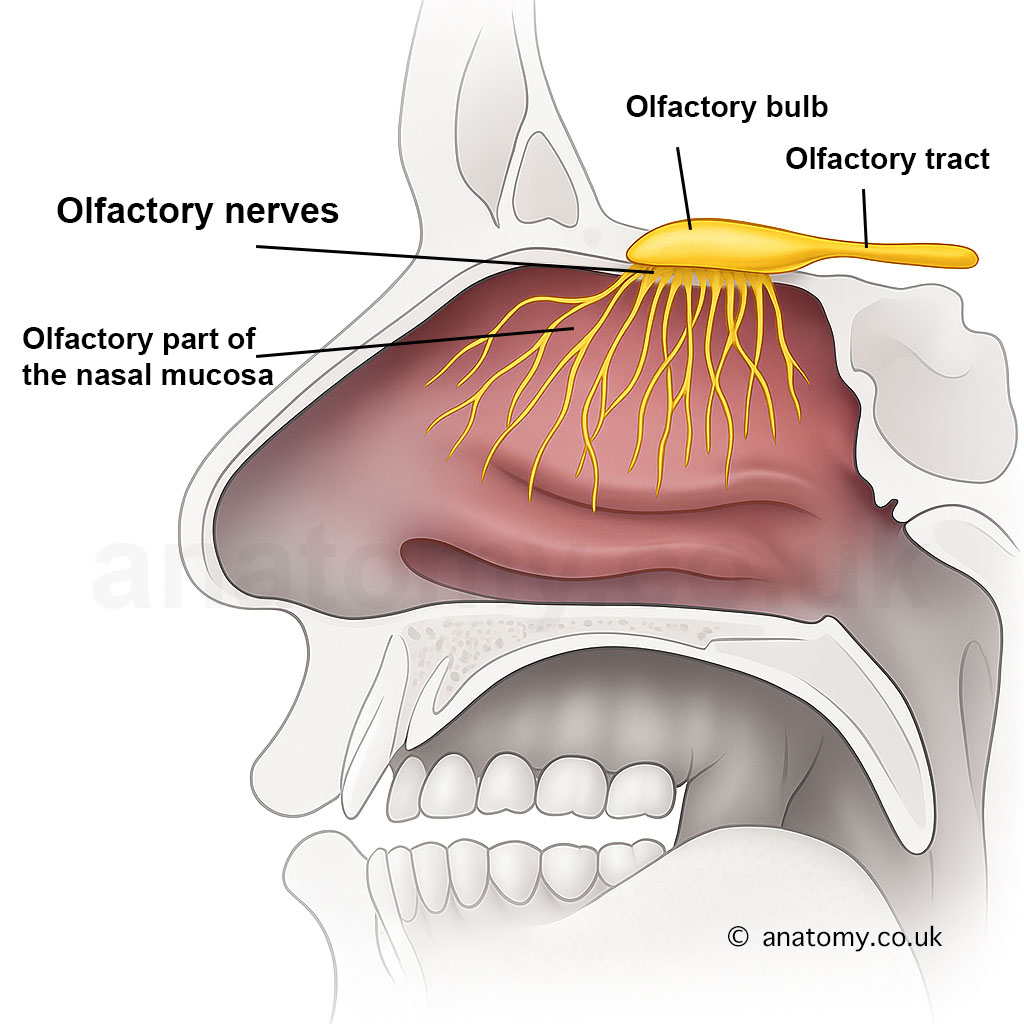ON
Olfactory nerve
Cranial nerve responsible for smell
RegionNeuroanatomy
SystemNervous System
The olfactory nerve, also known as the first cranial nerve, is a sensory nerve responsible for the sense of smell. It is a crucial part of the brain's limbic system, which is involved in memory, emotion, and behavior.
Structure & Size
The olfactory nerve is made up of several components, including the olfactory epithelium, the olfactory bulb, and the olfactory tract.

Olfactory Epithelium
The olfactory epithelium is a thin layer of tissue located in the upper part of the nasal cavity, just below the bony roof of the nose. It is made up of specialized cells called olfactory sensory neurons, which are responsible for detecting and translating smells into neural impulses. The olfactory epithelium is lined with cilia, tiny hair-like structures that are sensitive to chemical stimuli. When molecules in the air bind to these cilia, they trigger a neural response in the olfactory sensory neurons.
Olfactory Bulb
The olfactory bulb is a small, spherical structure located at the front of the brain. It receives and processes the neural signals from the olfactory epithelium, converting them into information that the brain can understand. The olfactory bulb is made up of several layers of nerve cells, including the glomerular layer, the mitral cell layer, and the granule cell layer. The glomerular layer is responsible for receiving and processing the neural signals from the olfactory epithelium. The mitral cell layer then sends these signals to the olfactory tract, which carries them to other parts of the brain. The granule cell layer plays a role in filtering and integrating the signals from the olfactory epithelium.
Olfactory Tract
The olfactory tract is a nerve pathway that carries the processed signals from the olfactory bulb to other parts of the brain. It is made up of two pathways: the lateral olfactory tract and the medial olfactory tract. The lateral olfactory tract carries the signals to the amygdala and the hippocampus, which are involved in emotion and memory. The medial olfactory tract carries the signals to the orbitofrontal cortex, which is involved in decision-making and behavior.
Location
The olfactory nerve is located in the upper part of the nasal cavity, just below the bony roof of the nose. It extends from the olfactory epithelium to the olfactory bulb, which is located at the front of the brain.
Function
The primary function of the olfactory nerve is to detect and interpret smells. When molecules in the air bind to the cilia in the olfactory epithelium, they trigger a neural response in the olfactory sensory neurons. These neurons then send a signal through the olfactory bulb and olfactory tract to the brain, where the smell is interpreted. The olfactory nerve plays a crucial role in the brain's limbic system, which is involved in memory, emotion, and behavior. The olfactory tract carries the processed signals from the olfactory bulb to the amygdala and hippocampus, which are involved in emotion and memory. It also carries the signals to the orbitofrontal cortex, which is involved in decision-making and behavior.
Clinical Significance
There are several clinical conditions that can affect the function of the olfactory nerve.
Anosmia
Anosmia is a condition in which a person is unable to detect smells. This can be due to a variety of causes, including damage to the olfactory nerve, infection, inflammation, or exposure to certain chemicals or toxins. Anosmia can have a significant impact on a person's quality of life, as it can affect their ability to taste food and drink, and can also be a warning sign of certain health conditions such as diabetes or a brain tumor.
Hyposmia
Hyposmia is a condition in which a person's sense of smell is impaired, but not completely lost. This can be due to a variety of causes, including damage to the olfactory nerve, infection, inflammation, or exposure to certain chemicals or toxins. Hyposmia can also be a symptom of certain health conditions such as chronic sinusitis or neurological disorders.
Olfactory Hallucinations
Olfactory hallucinations, also known as phantosmia, are a type of hallucination in which a person experiences smells that are not actually present. These smells can be unpleasant or pleasant, and can be triggered by a variety of factors including infection, inflammation, head injury, or certain medications. Olfactory hallucinations can be distressing for the person experiencing them, and can also be a sign of certain underlying health conditions such as epilepsy or a brain tumor.
Olfactory Training
Olfactory training is a therapeutic approach that involves using specific odors to help improve a person's sense of smell. This can be useful for people who have experienced a loss of smell due to injury or illness. Olfactory training typically involves exposing the person to a series of odors over a period of time, with the goal of helping them to identify and distinguish between different smells.
Published on December 21, 2022
Last updated on May 12, 2025
Last updated on May 12, 2025